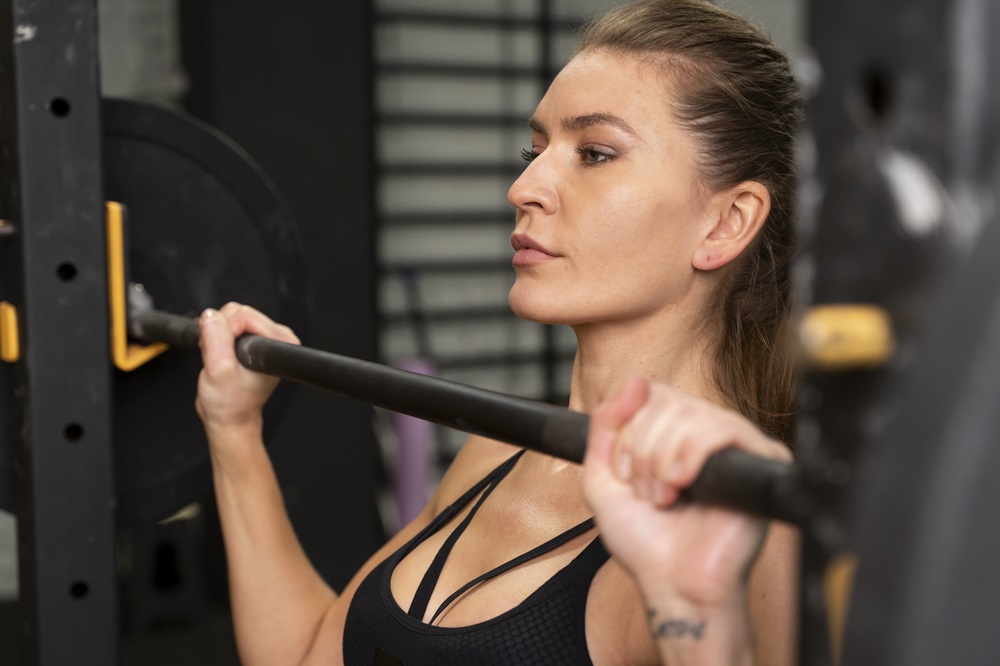Military Press – Muscles, Technique, Results

The Overhead Press, also known as the Military Press or simply OHP, is a popular compound movement among gym-goers. It’s a demanding but highly effective exercise that, when done correctly, can build upper-body strength and promote muscle growth. But what muscles does the overhead press target? What’s the proper form? And how can you safely add it to your workout routine?
Table of contents
What is the overhead press?
The Overhead Press (OHP) is a classic strength-training exercise where you press a weight from your upper chest straight up over your head. It’s a compound, multi-joint movement that heavily involves the shoulders and upper body. Once used in military settings to assess soldiers’ physical strength, this lift has become a fundamental part of strength and bodybuilding programs.
The OHP can be done in a variety of ways:
- Standing or seated
- Using different equipment: barbells, dumbbells, or kettlebells
Each variation offers slightly different benefits.
Muscles worked during the overhead press
The overhead press activates multiple muscle groups, making it one of the most efficient upper-body exercises.
Primary muscles involved:
- Deltoids (shoulders) – especially the anterior (front) delts
- Triceps – help extend the arms overhead
- Upper chest (pectoralis major)
- Upper back – including trapezius and infraspinatus
Supporting muscles that help stabilize the movement:
- Core (abdominals and obliques)
- Glutes
- Quads and hamstrings
Because of its full-body engagement, the OHP can also help with posture, stability, and overall upper-body coordination.
Proper technique - how to perform the standing overhead press
The most common version is the standing barbell overhead press. Here’s a step-by-step guide to doing it safely and effectively:
Warm up: Activate your shoulders and upper body with light dynamic stretches or resistance bands.
Starting position:
- Stand with your feet shoulder-width apart
- Keep your knees straight but not locked
- Unrack the barbell and rest it on your upper chest (collarbone level)
- Elbows should be slightly forward and bent at around 90 degrees
- Engage your core and glutes to keep your spine neutral
Pressing phase:
- Inhale
- Push the bar straight up over your head
- Keep your forearms vertical throughout the motion
- At the top, fully extend your elbows and bring your head slightly forward so the bar is directly above your shoulders
Lowering phase:
- Exhale
- Slowly lower the bar along the same path, returning it to chest level in a controlled motion
Overhead press variations
There are several ways to modify or perform the OHP depending on your goals and equipment:
- Seated overhead press – reduces strain on the lower back
- Dumbbell overhead press – allows for independent arm movement, helping correct imbalances
- Kettlebell overhead press – challenges stability and core engagement
- Push press – adds a small leg drive to assist with heavier loads
Choosing the right variation depends on your experience level, mobility, and training goals.
Benefits of the overhead press
Consistent training with OHP can lead to noticeable improvements in:
- Shoulder strength and mass
- Upper chest development
- Arm size and power (especially triceps)
- Postural stability and spinal support
- Functional strength – for lifting objects overhead in daily life
It’s also a great way to trigger anabolic hormones that support muscle growth.
Common mistakes to avoid
While powerful, the OHP requires proper form to avoid injury. Here are the most common mistakes:
- ❌ Leaning backward: Pushing your hips forward and arching your lower back puts stress on your spine.
- ❌ Flaring elbows outward: Letting elbows drift too far out from your body strains the shoulder joint and increases injury risk.
- ❌ Grip too wide: A grip that’s too wide can throw off bar path control and make it harder to keep your elbows aligned.
- ❌ Incomplete range of motion: Failing to lock out at the top or lowering the bar halfway reduces the effectiveness of the exercise.
- ❌ Shifting weight to toes or heels: Keep your body balanced – your feet should stay flat on the floor with even weight distribution.
- ❌ Pushing your head too far forward: This can strain your neck and lead to discomfort or injury.
Paying attention to form is key. If you’re new to OHP, it’s worth getting feedback from a coach or using lighter weight until the movement feels natural.
How often should you do the overhead press?
The ideal frequency depends on your training level and goals. Because the OHP is usually done with moderate to heavy weight, it’s important not to overdo it.
General recommendation:
- 2 to 4 sets
- 3 to 12 reps per set, depending on the goal (strength or hypertrophy)
- 1 to 3 times per week
Make sure to give your muscles enough time to recover, especially if you're training other upper-body lifts like bench press or pull-ups.
If you’re unsure how to program it into your routine, consider working with a certified personal trainer who can tailor a plan based on your needs.
Summary
The Overhead Press is a tried-and-true lift that targets a wide range of muscles and offers impressive strength and physique benefits. Done properly, it strengthens the shoulders, arms, and core, improves posture, and supports everyday functionality.
While simple in appearance, mastering the OHP requires attention to form, progressive loading, and listening to your body. Whether you use a barbell, dumbbells, or kettlebells, this foundational movement deserves a spot in your training program.

